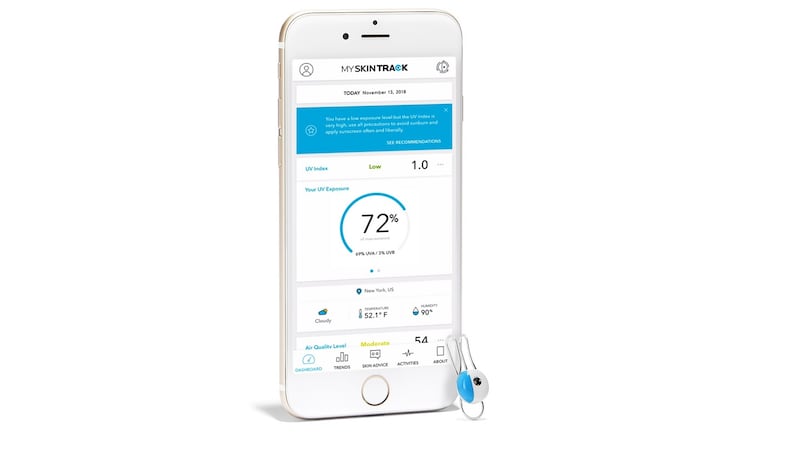Pollution is bad for us. UV exposure can also be problematic. If nothing else has sunk in over the years, at least we have taken in these messages. Skincare company La Roche-Posay (LRP) is hoping that we want to take notice of how it is affecting our skin too, enough to pay to find out.
The company has developed systems that help monitor everything from UV exposure to the air pollution we are exposed to daily. The latest is My Skin Track UV, a sensor and accompanying app that keeps track of your UV exposure, combines it with air quality and pollution, and then offers you skincare advice based on the results.
The sensor itself is tiny, about the size of a button. Inside the box you get a small clip that the sensors sits securely into – it’s almost impossible to get it in so once it’s there it can’t be dislodged unintentionally – and will attach to your clothing. Once it is there, it can track your exposure to the sun’s rays, and then combines with the app to keep note of other factors such as air quality and pollen. The idea is that you sync the sensor and the app at least twice a day, although it can hold up to three months of data for you. The more you sync it, the more accurate the recommendations made by the app will become.
To transfer that data, you’ll need a smartphone that supports NFC, which means one of the newer iPhones and most Android smartphones made in the last couple of years. The sensor itself is battery free, so no charging to remember. It’s a small NFC chip inside, which means this sensor – assuming you don’t mistreat it or put it through the washing machine – could go on forever. The sensor is water resistant, but only for 30 minutes in up to 3ft of water.
It doesn't look out of place when you are wearing it; it was created in collaboration with designer Yves Behar. You can clip it to your watch, put it on a necklace, attach it to your shoes. As long as it has some exposure to the light, and not covered up by your clothing, you should get an accurate reading.

The obvious advantage for LRP is that the skincare products it recommends are, naturally, all its own brand. It all seems a bit generic though. When I set up the app, I gave LRP some information on my skin – fair toned, normal skin – and the recommendations appear to be based more on that than the results of the sensor’s analysis. At the end of the day it is a tool to sell more skincare products, and it is worth keeping that in mind.
However, using the sensor did make me more aware of UV exposure. Before, I would have assumed that short stints outside with little or no sunscreen wouldn’t have resulted in too much UV exposure, and I’d got a bit lax on the SPF front. But according to the sensor, I reached what it terms “maximum sun stock” for my skin type in the space of about half an hour. A bit of a wake-up call, and it resulted in fresh resolve to remember the sunscreen every day.
There were a couple of hiccups. The second day, it resolutely registered zero UV exposure until the afternoon, despite being outdoors with the sensor in full view after 9am. Then I lost it for the first time – and certainly not the last. In fact the first three days I lost it four times where it had pulled off the collar of my T-shirt. Turns out the sturdy wire clip wasn’t infallible.
It will depend on where you attach it of course. A necklace will be reasonably secure. But it could do with the option of something a bit more secure to clip on to your clothing; I resorted to a safety pin at the back of the clip to keep it in place.
Another thing to note is that it won’t take account of sunscreen you’ve applied when it comes to calculating UV exposure. I’ve used some of La Roche Posay’s UV sensors before, most notably the patch that goes directly on your skin. You can’t cover My Skin Track UV with suncream, so although the app tells you that you have had 100 per cent of exposure to UVA rays, that doesn’t necessarily mean that it has actually reached your skin. You just have to keep reapplying the suncream regularly and hope it is doing its job.
The good:
Small, discreet and full of information, the Skin Track system will at least make you a little more aware of what your skin is dealing with daily.
The not so good:
The clip could be more secure and you don’t get skincare brownie points in the app for applying your sunscreen on a regular schedule.
The rest:
You can use the app to see how the contaminants in the air around you measure up to what is considered a safe level. But to use the system, you’ll need an NFC-enabled smartphone. Also, the system bills itself as measuring things in real time – but you have to initialise a sync to transfer the information to your smartphone, rather than observe it live, second by second.
The verdict:
A useful education tool, but keep in mind it’s also trying to sell you products.













